Why Do Dogs Get Zoomies After a Bath

If you’ve ever given your dog a bath, you know what often comes next. The moment the towel comes off, your calm pup transforms into a blur of energy. They race around the house, bounce off the couch, skid across the floor, and even roll in places you just cleaned. This sudden burst of wild energy is called the “zoomies.” Many pet parents wonder why do dogs get zoomies after a bath, and whether this behavior is normal or a sign of stress.
Bath time triggers unique emotions in dogs. Some pups love the water, while others dread the process. But no matter the reaction, many dogs end their bath with these high-speed sprints. Let’s dive deep into what zoomies are, why they happen, and how you can manage them while keeping bath time positive.
What Are Dog Zoomies?
Dog zoomies are sudden bursts of hyperactive behavior where your dog sprints, spins, or leaps around with no clear reason. In veterinary terms, this is called Frenetic Random Activity Periods (FRAPs).
Zoomies usually last only a few minutes, but they can happen anytime your dog feels overexcited, relieved, or playful. While it may seem chaotic, zoomies are your dog’s way of releasing pent-up energy.
Dogs get the zoomies in various situations after naps, during playtime, or when they see their favorite human come home. However, one of the most common times dogs get the zoomies is right after a bath.
Signs and Symptoms of Post-Bath Zoomies
Not every dog expresses zoomies in the same way, but here are common signs that your pup is experiencing post-bath zoomies:
- Running at high speed around the house or yard.
- Quick zig-zagging or spinning in circles.
- Bounding on furniture, rugs, or grass.
- Lowering the front legs while keeping the back legs up to invite fun.
- Excited vocalization during the sprint.
- Shaking water off with exaggerated body twists
- A big smile and wagging tail
If your dog gets zoomies after a bath, you might also see them rubbing against furniture, rolling on the ground, chewing on the towel and tug playfully while drying off.
Why Do Dogs Get Zoomies After a Bath?

There isn’t one single reason why do dogs get the zoomies after a bath. Instead, it’s a mix of instinct, emotion, and natural behavior. Let’s break it down.
Relief from Stress and Excitement
Baths can be stressful for some dogs. The sound of running water, slippery surfaces, or the restraint needed during washing may create tension. Once the bath ends, zoomies act as a release valve. It’s your dog’s way of shaking off that stress while celebrating freedom.
On the other hand, dogs that enjoy baths may feel pure excitement afterward. Running wildly is their way of expressing happiness.
Drying Off Their Fur
Dogs don’t enjoy staying wet. Even if you dry a dog after a bath with a towel, their coat often feels damp. Post-bath zoomies may be their attempt to speed up drying. Running, rubbing against furniture, or rolling on the floor helps spread moisture and fluff their coat.
In the wild, wet fur could lower comfort and body temperature. So, moving around helped dogs dry faster and stay warm.
Regaining Their Natural Scent
Shampoos and soaps often leave behind a fresh smell. While we humans love it, dogs don’t always agree. They rely heavily on their natural scent for comfort and communication.
Zoomies and rolling around may be a way for them to remove or mask the artificial smell and feel like themselves again. Some dogs will even head straight for grass or rugs to rub the scent off.
Pure Joy and Playfulness
Not all zoomies are about stress or discomfort. Sometimes, dogs getting zoomies simply means they feel refreshed and happy. The sensation of being clean, towel-dried, and cared for can spark pure joy, and zoomies are their way of celebrating.
Are Post-Bath Zoomies Normal?
Yes, post-bath zoomies are completely normal. Dogs get the zoomies for many reasons, and after a bath is one of the most common triggers.
In most cases, zoomies are harmless and last only a short time. They are a natural outlet for your dog’s emotions and energy. However, if zoomies seem extreme, destructive, or paired with signs of fear, it may indicate bath time is too stressful for your dog.
How to Stop or Reduce Post-Bath Zoomies
While zoomies are natural, they can sometimes be risky. Slippery floors, sharp corners, or cluttered rooms can turn playful sprints into injuries. If you want to reduce zoomies:
- Let your dog run in a safe, enclosed area after a bath.
- Provide a towel or blanket where they can roll instead of your rug.
- Engage them with a toy to redirect energy.
- Use calming cues like gentle petting or treats.
- Keep the environment calm during and after bathing.
If your dog regularly experiences zoomies, try adjusting your bath routine to make it less stressful.
6 Tips to Make Bath Time Less Stressful for Dogs

Bathing doesn’t have to feel like a battle. Many dogs get anxious around water, slippery tubs, or even the sound of running faucets. By making a few simple adjustments, you can turn bath time into a calm and positive experience for both you and your pup. Here are six practical tips:
Use Lukewarm Water
Dogs are sensitive to water temperature. Too hot or too cold can cause discomfort and increase stress. Always use lukewarm water. It feels natural and soothing on their skin.
Choose a Gentle, Dog-Safe Shampoo
Harsh products can irritate your dog’s skin and leave behind strong scents they dislike. Select a mild, pH-balanced shampoo made specifically for dogs. Many pet parents often wonder, “what shampoo do dog groomers use?” Professional groomers typically choose shampoos that are gentle, hypoallergenic, and effective at cleaning while keeping coats shiny and healthy. Picking the right shampoo not only protects your dog’s skin but also reduces post-bath zoomies caused by irritation.
Provide Non-Slip Support
Slipping in the tub makes dogs feel insecure. Place a rubber bath mat or towel at the bottom of the tub to give your dog traction. If possible, invest in dog grooming bath tubs, as they are designed with non-slip surfaces and built-in restraints that keep your pup safe and comfortable.
Reward Calm Behavior
Positive reinforcement works wonders. Keep treats on hand and reward your dog for calm behavior throughout the bath. Praise and small rewards build a positive association, making each bath easier than the last.
Keep Sessions Short and Sweet
Prolonged baths increase stress. Aim for quick, efficient washes while still being thorough. Have your supplies ready before starting, so the process flows smoothly and minimizes your dog’s discomfort.
End on a Positive Note
Once the bath is over, make sure your dog remembers the experience in a good way. Towel dry them gently, give a favorite toy, or spend a few minutes playing together. Ending on a positive note helps your dog look forward to bath time instead of dreading it.
When Should You Be Concerned About Zoomies?
Zoomies are usually harmless. However, you should watch for warning signs.
- If zoomies lead to constant destructive behavior.
- If your dog injures themselves while sprinting.
- If zoomies are paired with signs of anxiety or aggression.
- If your dog avoids baths altogether due to extreme fear.
In these cases, consult a professional trainer or seek veterinarian care. Excessive stress may require desensitization training or medical advice.
Want to Master Dog Grooming and Understand Behaviors Like Zoomies?

If you want to go beyond basic grooming and truly understand your dog’s behavior, enrolling in PDGA dog grooming courses is the perfect step. These courses don’t just cover brushing, bathing, or nail trimming, they also teach you why dogs act the way they do during and after grooming.
From handling a nervous pup in the bath to managing post-bath zoomies safely, PDGA gives you the knowledge and hands-on skills to make grooming stress-free and enjoyable. Whether you’re a pet parent who wants to improve at-home care or someone aiming to start a professional career in grooming, these courses provide expert guidance.
By mastering dog grooming through PDGA, you’ll learn everything from coat care to behavior management. And the best part? You’ll gain confidence in handling all breeds, temperaments, and situations turning bath time into a bonding experience instead of a challenge.
Conclusion
So, why do dogs get zoomies after a bath? It’s a mix of relief, joy, drying needs, and scent recovery. These wild sprints are normal, healthy, and often hilarious.
Instead of worrying, focus on making bath time stress-free. Provide safe spaces for zoomies, use gentle grooming tools, and dry your dog properly. If your dog gets zoomies that seem extreme or unsafe, a little extra training or professional help may be the answer.
At the end of the day, zoomies are a sign of life, energy, and happiness. They remind us that dogs express emotions in the most delightful ways. Next time your dog races around after a bath, smile and enjoy the moment. It's just their way of saying, “I feel great!”




